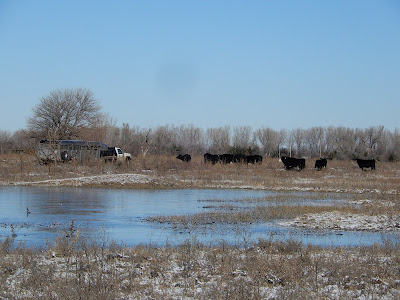
Truthfully, I'm not sure that number is high enough. But, as I stood waiting on the tractor to again pull the pickup and trailer through mud and muck, it's what went through my mind. It was more like mud wrestling than farming around here this fall.

So, am I exaggerating about the 35? Nope.
First of all, we were a couple weeks behind schedule. We had waited until mid-November, hoping the water on our normal route would recede after the 14-plus inches of fall rain we'd received.
We couldn't wait any longer, so we added 12 miles to each of our trips to and from the pasture, since we had to go the long way around. (We made a total of 12 trips, so that's an extra 144 miles. See? I told you 35 wasn't exaggerating!)
In fact, it rained and deposited another 2 inches or so of rain, and it snowed a couple of times for good measure, including on the night before we were supposed to round up all the cattle at the Ninnescah.


But it was a brisk 4-wheeler ride to find the mamas and babies and get them to cross water into the pens and corral.
Still, the ride over the dam on the Ninnescah River was undeniably pretty.
Of course, a few of them were "visiting" a neighbor's pasture, so it added another step to the process.


The ground was so saturated that a 4-wheel-drive pickup couldn't pull a trailer by itself. So each trip to the pasture also necessitated hooking up the loader tractor to the pickup and pulling it back out to the road.

At first, Randy planned to have the loaded trailer "limp" all the way home. But one of the tires was leaving a dark mark on the blacktop road, and I started campaigning for an alternative. What if the trailer totally broke down on U.S. Highway 50, a route we had to take for several miles to get back home? I was envisioning trying to transfer cattle from one trailer to another while semis whizzed by.

Getting the cattle to step from one trailer to the other is usually the bigger challenge, he contended. He and his Dad had to do it a long time ago. But the mamas and babies cooperated well. (Maybe they knew we were about at the breaking point.)
We did eventually get all the mamas and babies moved back home. The mamas had their OB/GYN appointments with Dr. Figger ...
... and the babies had their "well-child" checks.
(And, I could add more to the number of ways things went wrong during that process, too. The hired man got hurt - not badly, thankfully. But he was out of commission for an afternoon. So I did a lot more heavy lifting than I sometimes have to do. Literally, I did heavy lifting. After we got cows or calves into the lane toward the working chute, I lifted an awkward 20-pound pipe and inserted it behind the final one to keep them in position. When you only have four or five mama cows in the lane at once, that's a lot of lifting! It's the farm version of weight training.)
But, we eventually got everyone moved to their appointed places. Some of the mamas are on sudan or corn stalks while they await the births of their new babies in February.
The feeder calves are getting their daily rations with the feed truck.
And, for a couple of weeks, I was the feed truck driver and full-time hired hand.

They looked over the herd with Grandpa to observe any problems.
And they just brightened our outlook, in general.
They also helped move some of the mama cows and used their newly-developed hand motions to get them moving out of the trailer and into their winter home. Reading hand signals is an integral part of farm-girl education.
I wonder if they're free next fall?
Note: We actually moved cattle home from summer pastures in mid-November. I never got the blog post written - visiting granddaughters, holiday preparations, personnel problems ... the list goes on and on. But I still thought we needed a record of this memorable year. And by memorable, I don't mean enjoyable ... except the granddaughters. That part was enjoyable! As I've said in the past, it's important to tell about the hard stuff, too - not just the gorgeous sunrises and sunsets but what actually went on between them.













As if moving cattle (especially heifers!!) isn't already hard enough. I'm sure you're glad that part is over! Here's to some SUNSHINE to dry things out!!
ReplyDelete2018 was a challenging year. Here's to 2019!
DeleteKim I loved reading about the hard stuff. Who'd be a farmer's wife? Sincerely hope that 2019 is a more relaxed year on the farm.
ReplyDeleteYour new header is awesome.
The header photo is a favorite from another year. Thank you!
Delete